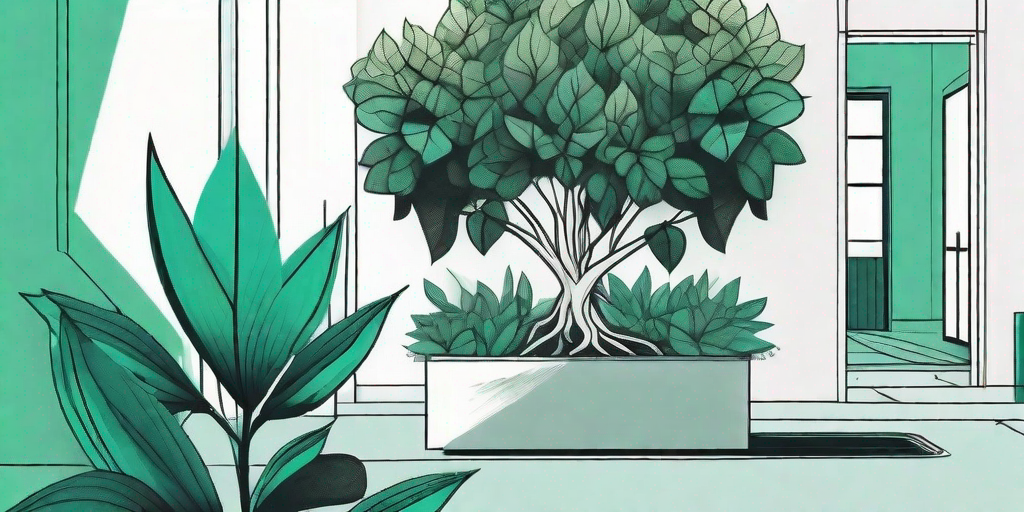
Welcome to the world of gardening, where the magic of nature meets the creativity of human hands. Today, we're going to talk about a plant that is as tough as it is beautiful - the outdoor rubber tree. This hardy plant, with its glossy, deep green leaves, is a fantastic addition to any garden. But don't let its beauty fool you, this plant is as resilient as they come. Let's dive in and explore the wonders of the outdoor rubber tree.
The Resilient Outdoor Rubber Tree: An Overview
Native to Southeast Asia, the outdoor rubber tree, scientifically known as Ficus elastica, is a popular choice among gardeners worldwide. It's not just its beauty that makes it a favourite, but also its hardiness. This plant can withstand a wide range of conditions, making it a perfect choice for both beginners and seasoned gardeners.
The outdoor rubber tree is a fast-growing plant that can reach up to 50 feet in height. Its large, glossy leaves can grow up to 12 inches long, giving it a lush and tropical appearance. But what truly sets it apart is its ability to withstand harsh conditions, from poor soil to low light levels. Now, let's delve deeper into the world of the outdoor rubber tree.
Planting and Caring for Your Outdoor Rubber Tree
Choosing the Right Spot
While the outdoor rubber tree is a resilient plant, it still needs the right conditions to thrive. It prefers a spot with indirect sunlight and well-drained soil. Too much direct sunlight can scorch its leaves, while waterlogged soil can lead to root rot.
When choosing a spot for your outdoor rubber tree, consider its growth potential. This plant can grow quite large, so make sure it has enough space to spread its branches. A spot near a fence or a wall can provide the necessary support for its growth.
Watering and Fertilizing
Watering your outdoor rubber tree can be a bit of a balancing act. It likes its soil to be moist, but not waterlogged. A good rule of thumb is to water it when the top inch of soil feels dry to the touch. Overwatering can lead to root rot, a common problem with this plant.
As for fertilizing, your outdoor rubber tree will appreciate a good feed during the growing season. Use a balanced, water-soluble fertilizer and apply it according to the package instructions. Remember, it's better to under-fertilize than over-fertilize.
Common Problems and Solutions
Yellowing Leaves
Yellowing leaves can be a sign of overwatering. If you notice this, cut back on watering and make sure your plant's soil is well-drained. If the problem persists, you may need to repot your plant in fresh soil.
Another cause of yellowing leaves is too much direct sunlight. If your plant is in a spot that gets harsh afternoon sun, consider moving it to a spot with more indirect light.
Leaf Drop
Leaf drop is a common issue with the outdoor rubber tree, especially during the winter months. This is usually a response to lower light levels and cooler temperatures. Don't panic, this is a normal part of the plant's life cycle. Just make sure to keep it away from cold drafts and provide it with enough light.
Overwatering can also cause leaf drop. If you notice this, cut back on watering and make sure your plant's soil is well-drained.
Frequently Asked Questions
- Can I grow an outdoor rubber tree indoors?
Yes, you can! In fact, the outdoor rubber tree is a popular indoor plant due to its low light tolerance and easy care. Just make sure to provide it with enough indirect light and water it when the top inch of soil feels dry to the touch.
- How often should I water my outdoor rubber tree?
There's no set schedule for watering an outdoor rubber tree. It depends on the conditions in your garden. A good rule of thumb is to water it when the top inch of soil feels dry to the touch.
- Why are the leaves on my outdoor rubber tree turning yellow?
Yellowing leaves can be a sign of overwatering or too much direct sunlight. Cut back on watering and move your plant to a spot with more indirect light.
Conclusion
The outdoor rubber tree is a beautiful and resilient plant that can add a touch of the tropics to any garden. With its glossy leaves and hardy nature, it's a plant that's sure to impress. So why not give it a try? With the right care, you can unleash the beauty of your garden with the resilient outdoor rubber tree.
Remember, gardening is not just about growing plants. It's about enjoying the process, learning from your mistakes, and celebrating your successes. So go ahead, get your hands dirty, and let the outdoor rubber tree bring a touch of magic to your garden.















